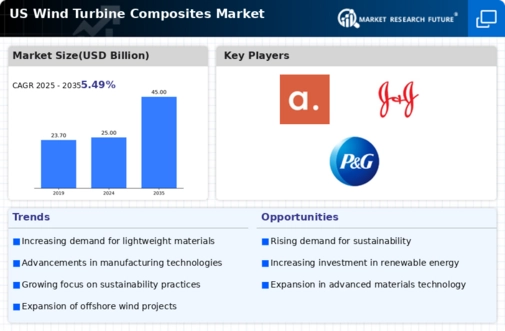The competitive landscape of the US Wind Turbine Composites Market is characterized by a diverse range of players, each contributing to the advancement of wind energy technologies. This market has seen significant growth driven by the increasing adoption of renewable energy and the expansion of wind farms across the United States. Companies in this sector focus on developing innovative composite materials that enhance the performance and durability of wind turbine components, such as blades and nacelles. The competition is largely based on technological advancement, production capabilities, and the ability to forge strategic partnerships, which significantly impact market positions.
The push towards sustainability and efficiency has also led to a race among various industry stakeholders to offer environmentally friendly solutions while reducing costs.LM Wind Power stands as a prominent entity in the US Wind Turbine Composites Market, renowned for its expertise in manufacturing wind turbine blades with composite materials. The company has established a robust market presence through its commitment to innovation and quality. Its strengths lie in a strong research and development framework that continuously improves existing product lines and develops new technologies aimed at increasing the efficiency of wind turbine operation.
LM Wind Power's extensive experience in the industry allows it to deliver high-performance products tailored to meet specific client needs, fostering long-term partnerships with leading turbine manufacturers in the region. Additionally, the company's focus on sustainable practices and reducing carbon footprints aligns well with the growing preferences for eco-friendly solutions in the energy sector.Dow has carved out a significant niche in the US Wind Turbine Composites Market by offering a broad portfolio of advanced materials and solutions tailored for wind energy applications.
The company specializes in producing high-performance resins, adhesives, and other composite materials essential for constructing durable and lightweight turbine components. Dow's strengths include a strong commitment to research and innovation, which has led to the development of several key products geared towards enhancing turbine blade performance and longevity. The company's market presence is further bolstered by strategic mergers and acquisitions that have expanded its capabilities and product range. Dow actively collaborates with wind turbine manufacturers, engineering firms, and other stakeholders to provide tailored solutions that meet the evolving demands of the energy sector in the US.
This collaborative approach, combined with its extensive technical expertise, ensures that Dow remains at the forefront of material science innovations in the wind energy market.














Leave a Comment